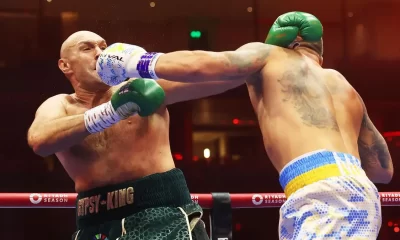Sports
Formula 1 2022: Lewis Hamilton and Max Verstappen return to the track
Formula 1 2022: Lewis Hamilton and Max Verstappen return to the track
Lewis Hamilton and Max Verstappen return to the track for the Formula 1 2022 season;what’s going to happen?
Three months on from the tumultuous climax to the 2021 championship, a new one begins with the shadows of that day in Abu Dhabi still hanging over the sport.
After losing an eighth world drivers’ title in controversial and painful circumstances, Lewis Hamilton and his Mercedes team are trying to move on, at least in public.
The man who beat him, Max Verstappen, probably starts the new season as favourite, but his Red Bull team principal Christian Horner continues to snipe, throwing various accusations at Mercedes. That they “bullied” the sport’s governing body into making changes; they mounted a campaign to discredit Verstappen’s title, and so on.
Meanwhile, the ramifications of a day on which the sport’s referee made up the rules as he went along continue to reverberate. The FIA, recognising that errors were made at Yas Marina, has indeed made changes.
A report into the events of the day is expected to be published this weekend. But already race director Michael Masi has been moved into a different role, his freestyling with the rules under extreme pressure at Yas Marina judged to have made his position untenable.
In his place, two people will alternate in a role that is not meant to be so high profile. A more robust structure has been put in place around them. And a face from the past has been brought back to try to add a little gravitas and experience.
The new race directors will be advised by Herbie Blash, F1 veteran and long-time associate of the late FIA F1 director Charlie Whiting, whose death on the eve of the 2019 season saw Masi elevated into the role he has now lost.
As if that was not enough to be going along with, the sport’s rule book has been ripped up and rewritten from scratch. An all-new set of technical regulations has been introduced in the hope of producing cars that are closer in terms of performance, and can race more effectively, too.
The cars’ front and rear wings have changed to smooth airflow
The cars
The cars that will be seen on track over the 22 or 23 races between now and mid-November are the product of four years of research by F1 and the FIA, and two years of development work by the teams.
After extensive analysis by a team under F1 managing director Ross Brawn, the cars’ aerodynamics have been fundamentally revised, in an attempt to ensure drivers can follow each other more closely. And the rules have been made deliberately prescriptive to try to reduce the performance gap between the front and back of the field.
The fear was that this would create a field of lookalikes. But in fact there is more visual variation between the 10 cars than for some considerable time, much to the relief of both the teams themselves, and the sport’s aficionados.
The three teams expected to lead the way at the start of the season – Red Bull, Ferrari and Mercedes – have all taken strikingly different approaches to solving the same set of problems.
Mercedes have shrunk their car’s bodywork to such an extreme extent that its sidepods are almost not there. Red Bull have created dramatic cutaways underneath theirs. And Ferrari’s are almost bulbous, but with elegant scallop-type curves cut out of the top of them. Even the cars’ noses are different – Ferrari’s narrow and needle-like against the more conventional, squarer ones of Mercedes and Red Bull.

Who seems to be fastest?
The three big teams ended pre-season testing fastest, with lap times within a few tenths of a second of each other. But Red Bull looked strongest, and not just because Verstappen set the quickest time.
Ferrari showed the most consistent performance, while Mercedes looked on the back foot. McLaren, promising early in testing, hit reliability problems later on that need solving before the car hits the track this weekend.
Hamilton has said he “doesn’t think we’ll be competing for wins” at the start of the season. Verstappen is treating that claim with scepticism. He harked back to previous years in which a difficult pre-season for Mercedes was followed by a victory at the first race, when he said of the world champion’s attempts to play down expectations: “It’s always like this.”
Out on track, though, the Mercedes did appear to be in trouble. It was clearly a handful for its drivers, Hamilton and highly rated new recruit George Russell. And Alpha Tauri’s Pierre Gasly, who spent a couple of laps following Hamilton on the final day of testing, backed up his claims.
“I could see Lewis was struggling and I think they do have some work to do to be fighting right at the top,” the Frenchman said. “But it’s only testing.”

Bouncing cars and ‘porpoising’
The Mercedes was suffering badly with a phenomenon that has not been seen in F1 for 40 years – ‘porpoising’.
This is a kind of high-frequency bouncing caused by an aerodynamic disruption to which these cars are vulnerable following the rule changes.
It’s a word from the past – it was commonplace back in the late 1970s and ’80s, when the ‘ground-effect’ aerodynamics that have been reintroduced with these cars were last permitted. But almost no-one in an engineering position in F1 now was around back then, and its occurrence caught all the teams by surprise.
One man who was around in the early 1980s was Adrian Newey, Red Bull’s chief technical officer, who was just starting his career as the last ground-effect era came to an end.
Can it be a coincidence that Red Bull seem most on top of the phenomenon? They seemed not to experience it at all once their final upgrade was introduced on the last day of testing.
For all Verstappen’s scepticism, the GPS speed traces to which all teams have access backed up Mercedes’ claims. Their main time loss was in the corners – which belies the suggestion from Ferrari that their apparent lack of pace was caused by them using their engine in a lower power mode.
The Ferrari was especially good in slow corners, struggling in the quicker stuff, and not so great on the straights. The Red Bull seemed to be strong everywhere.
Hence Verstappen’s status as favourite. The Dutchman is a phenomenon, a force of nature. His 2020 season was outstanding, even if his uber-aggressive racing tactics are not to everyone’s liking, and he’s a talent worthy of the title of world champion regardless of one’s views of what transpired in Abu Dhabi.
If the Red Bull is as good as it looks, Verstappen will take some stopping. But it should be borne in mind that, after such a huge regulation change, development rates will be high, and the destiny of the championship will likely depend on who can add the most pace to their car over the season, while staying within the budget cap, lowered this year by $5m to $140m.

Will the racing be closer?
It’s an old cliche in F1, but no less true for that, that a true picture of the shape of the season will only begin to be formed after a few races.
Brawn is confident the changes he has overseen will work. Regardless, for now, the impression that the field spread does seem to be reduced, and some positive signs about the cars’ raceability need to be treated with caution.
A number of drivers said during testing that it did appear to be easier to follow more closely, in that the amount of grip they lost seemed to be reduced.
But some added that the ‘tow’ effect – a speed gain created when close behind a car because of the hole in the air it creates – had been reduced, and said the one might cancel out the other.
Then there is the question of the tyres. Since Pirelli came into F1 as sole supplier in 2011, the tyres have been prone to overheating. This has meant drivers have had to drive within themselves much of the time to keep the rubber within the required temperature threshold.
This had two related effects – drivers were usually well under the cars’ limit, and racing was difficult because if a driver pushed to try to overtake, the tyres would quickly overheat.
Among the rule changes this year was the introduction of bigger wheels and lower-profile tyres, and Pirelli was asked to change the tyre design to make them more robust – less sensitive to overheating and more durable, so drivers could push closer to the limit all the time, and race harder. After all, there is not much point creating more ‘raceable’ cars if the tyres turn into liquorice when you’re trying to follow another car.
There are mixed messages as to whether this has been successful. In one news conference this winter, Aston Martin’s Lance Stroll said the tyres were no different in their characteristics, only for Ferrari’s Carlos Sainz to say he was more optimistic about Pirelli having been successful to some extent.
In Bahrain last week, the sport’s two most successful active drivers had their say. Four-time champion Sebastian Vettel pointed out that heavier cars meant “the challenge to Pirelli has increased”, adding: “We need to wait and see – see how it feels, see if we can race closer and harder, or whether we start sliding.”
Hamilton, meanwhile, was scathing. “The tyres are worse this year,” he said. “Following behind another car looks a little better, which is hopefully the right direction. I hope we can maybe get some better tyres at some stage, or maybe they work better in places not so hot.”
What else has changed?
F1 did a remarkable job over the past two years to stage two full seasons in the midst of the pandemic. Now the threat of Covid-19 seems to be receding, it has ambitions to host its longest-ever season at 23 races, crammed into a month’s less time than the 22 events of 2021.
The season ends in mid-November rather than mid-December so as not to clash with the Fifa World Cup.
One race has already fallen by the wayside, the Russian Grand Prix cancelled for the foreseeable future as a result of the invasion of Ukraine, but F1 aims to replace it. And to hold so many races in such a short time, changes have been made to the weekend structure.
The idea is to cut F1 weekends from four days to three, to lessen the load on the teams. The first casualty is the media day on Thursday – now, the news conferences are on Friday morning before a later start to practice. It’s going to mean a very long day for everyone on the Friday before the competition proper starts on Saturday.
Attempts to double the number of ‘sprint’ events to six foundered on a row over money, so there will be three of those again.
But the big test is the rules. Will this new era really be better and brighter than ever, the competition closer throughout the field?
After the last era ended with one of the greatest seasons in history, it has a lot to live up to.
Bahrain on Sunday will begin to provide the answers as to whether this grand experiment will succeed.
Credit:BBC,Getty Images,CN


 Politics23 hours ago
Politics23 hours agoWe Will Bury PDP, Ibori’s Daughter Blows Hot

 Sports23 hours ago
Sports23 hours agoOleksandr Usyk defeats Tyson Fury to tetain heavyweight title

 News23 hours ago
News23 hours agoNigerian Emergency Agency NEMA Puts All Offices On Alert Over Fatal Stampedes

 Sports23 hours ago
Sports23 hours agoCAF Made Me Believe I Won – Achraf Hakimi

 Top Stories23 hours ago
Top Stories23 hours agoEmefiele: EFCC secures final forfeiture of 1.925 hectares of landed property linked to former CBN Governor
- News11 hours ago
NIGERIAN BREWERIES PARTNERS OZA CARNIVAL









